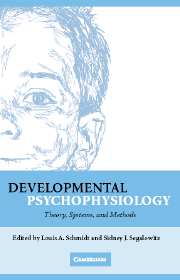Book contents
- Frontmatter
- Contents
- Foreword by Stephen W. Porges
- Preface
- Acknowledgments
- Contributors
- 1 Capturing the Dynamic Endophenotype: A Developmental Psychophysiological Manifesto
- SECTION ONE CENTRAL SYSTEM: THEORY, METHODS, AND MEASURES
- 2 Event-Related Brain Oscillations in Normal Development
- 3 Event-Related Potential (ERP) Measures in Auditory Development Research
- 4 Event-Related Potential (ERP) Measures in Visual Development Research
- 5 Electrophysiological Measures in Research on Social and Emotional Development
- 6 The Use of the Electroencephalogram in Research on Cognitive Development
- SECTION TWO AUTONOMIC AND PERIPHERAL SYSTEMS: THEORY, METHODS, AND MEASURES
- SECTION THREE NEUROENDOCRINE SYSTEM: THEORY, METHODS, AND MEASURES
- SECTION FOUR DATA ACQUISITION, REDUCTION, ANALYSIS, AND INTERPRETATION: CONSIDERATIONS AND CAVEATS
- Index
- References
2 - Event-Related Brain Oscillations in Normal Development
from SECTION ONE - CENTRAL SYSTEM: THEORY, METHODS, AND MEASURES
Published online by Cambridge University Press: 27 July 2009
- Frontmatter
- Contents
- Foreword by Stephen W. Porges
- Preface
- Acknowledgments
- Contributors
- 1 Capturing the Dynamic Endophenotype: A Developmental Psychophysiological Manifesto
- SECTION ONE CENTRAL SYSTEM: THEORY, METHODS, AND MEASURES
- 2 Event-Related Brain Oscillations in Normal Development
- 3 Event-Related Potential (ERP) Measures in Auditory Development Research
- 4 Event-Related Potential (ERP) Measures in Visual Development Research
- 5 Electrophysiological Measures in Research on Social and Emotional Development
- 6 The Use of the Electroencephalogram in Research on Cognitive Development
- SECTION TWO AUTONOMIC AND PERIPHERAL SYSTEMS: THEORY, METHODS, AND MEASURES
- SECTION THREE NEUROENDOCRINE SYSTEM: THEORY, METHODS, AND MEASURES
- SECTION FOUR DATA ACQUISITION, REDUCTION, ANALYSIS, AND INTERPRETATION: CONSIDERATIONS AND CAVEATS
- Index
- References
Summary
CONCEPTUAL FRAMEWORK
Recently, event-related neuroelectric oscillations have provided important tools with which to study information processing in the brain and with which to enrich our knowledge of brain maturation and cognitive development. The essential advantages of this approach are the ability to (1) analyze neuroelectric responses reflecting mechanisms of stimulus information processing in comparison to electrical activity in a passive state reflecting the neurobiological maturation of the brain; (2) refine electrophysiological correlates of information processing by separating functionally different but simultaneously generated responses from different frequency ranges; and (3) reveal differential developmental dynamics of the power and synchronization of neuroelectric responses, thus providing information about independent neurophysiological mechanisms during biological and cognitive development.
In this chapter, the conceptual background of event-related oscillations will be presented with a major focus on their relevance for developmental research, followed by methods, analytic tools, and parameters for assessment of event-related oscillations. Finally, major findings on the development of the delta, theta, alpha, and gamma response systems in the brain will be described.
EVENT-RELATED POTENTIALS
The electroencephalogram (EEG) is a time-varying signal reflecting the summated neuroelectric activity from various neural sources in the brain during rest or functional activation. An EEG response that occurs in association with an eliciting event (sensory or cognitive stimulus) is defined as an event-related potential (ERP). However, the ERP may contain EEG activity not related to specific event processing, as well as electric activity from non-neural sources.
- Type
- Chapter
- Information
- Developmental PsychophysiologyTheory, Systems, and Methods, pp. 15 - 68Publisher: Cambridge University PressPrint publication year: 2007
References
- 1
- Cited by



